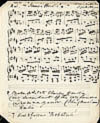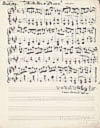




Please click any thumbnail image to view the full details.
There are 900 entries.
5 > 6 > 7 > 8 > 9 > 10 > 11 > 12 > 13 > 14 | next 10 of 90 pages
| Image | Title | Item Description |
|---|---|---|
 JSS0091 |
The Perthshire Hunt | This reel follows the previous strathspey The South of the Grampians (JSS0090) in Skinner's published Harp and Claymore collection. Miss M. Stirling of Ardoch, Perthshire, was a friend of Niel Gow (see JSS0082) and his son Nathaniel who published some of her tunes in their collections. She was one of the few women composers of dance music in the traditional style. She also published her compositions under her own name. Listen to Skinner playing the Perthshire Hunt by clicking on the audio link below. |
 JSS0092 |
Bob Steele | Manuscript in Skinner's hand of: Strathspey / 'Bob Steele'* composer unknown. Below the D major tune Skinner provides some of the tune's alternative titles: * also known as The Miller o' 'Dervil' and Brig o' Ayr, New Brig o' 'Dee' - Reel to follow. 'Jamie Hardie'. Before the Harp and Claymore appeared, he found another, Johnie Steele, and used that instead. The published bass line in the first section is slightly altered in harmony, and all the notes are in octaves. But all of Skinner's directions (bowing and phrasing) to the violinist remain unchanged. |
 JSS0093 |
Jamie Hardie | Manuscript in Skinner's hand of 'Reel - 'Jamie Hardie'* - 1st time published / J. Scott Skinner. * Brother of the late Charles Hardie (and descendant of the once famous Drumnagarrow (John Strachan) (see JSS0101, JSS0102). Reel to follow 'Bob Steele'. (Bob Steele, JSS0092, is called Johnie Steele in the Harp and Claymore.) The bass line differs in the published version, although it remains simple. The dynamic f (loud) and is added to the first bar of the second section, and ff (very loud) replaces 'with force', in the next last bar. |
 JSS0094 |
Tullochgorum | Manuscript in Skinner's hand of 'Strathspey - Tullochgorum = composer MacPherson (?) / 17th century''. Above the title is: Dorian Mode / Flat 7th. The Corn Bunting. The Dark blue Hill. (sic). Below the music he adds: 'the wee notes (the low Gs, unfingered, or 'open', G strings) in the first strain (section) are the fluttering leaves which vibrate in sympathy.' At bottom right is: Var(iation)s over(page)'. This is the main tune as printed in the Harp and Claymore. There, it is described as an Old "Strathspey Reel." Skinner gives no composer, but writes: First printed in (Robert) Bremner's Collection, 1737. |
 JSS0095 |
Tullochgorum | Printed music of Tullochgorum, unaccompanied melody and four variations, from Skinner's The Scottish Violinist (1900). Below the title the words 'From the Harp and Claymore' are crossed out. They were included in error, since that collection didn't appear until four years later. Both collections were published by Bayley and Ferguson, Glasgow, who could have copied the old variations from this page for the new Harp and Claymore. |
 JSS0096 |
Tullochgorum | Skinner's manuscript note on the background to Tullochgorum (JSS0094, JSS0095). 'Here are the original notes from which Tullochgorum sprang: - "Jackie's Fou (drunk) and Jennie's Fain" -'. The music is a quick sketch of a 16-bar melody in G major, and 2/4 time, 'kindly communicated by Mr A. Troup. Glued onto the page parallel to the edge is 'Note to Tullochgorum. This tune is of great antiquity & this is borne out by Miss Montgomerys request that the Rev. John Skinner should write words to the ancient 'Reel of Tullochgorum - it is known to a few lovers of the strathspey as 'The corn bunting' (inserted) and 'Jockie's fou and Jennie's fain'. See A Guide to Strathspey by Rev. Wm Reid D. D. Edin(burgh) - Angus Stuart, Pub: Granton on Spey.' |
 JSS0097 |
The Marquis of Huntly's Farewell | Skinner's note reads: The three successive identical notes in the original (1st bar of 1st [line?]) is now considered obsolete.' He writes two short music examples: the 'obsolete' rhythm [two semi-quavers, quaver, on the fifth] has changed to a semi-quaver on the third, and a dotted quaver on the fifth. 'We are progressing?', he asks. Below is '+ 1st Prize - as played by Scott Skinner at Inverness Violin Contest Sept. 1863 -'. Then, another music example: 'here is a more florid refrain:- .' Click below to listen to Skinner playing this. |
 JSS0098 |
The Miller o' Hirn | Manuscript in Skinner's hand of his Schottische or Strathspey, 'The Miller o' Hirn'. He quotes: 'The fire o' Feugh is in its sough'. For the quotation, ' See 'Dreams o' Hame' by J. D. Law.' John Johnston, the Miller at Hirn, near Banchory, was also the dedicatee of Skinner's 'Miller o' Hirn' collection (1881). You can listen to Skinner playing his well-known melody by clicking on the audio link (cd17b). |
 JSS0099 |
The Miller o' Drone | Manuscript in Skinner's hand of his arrangement of the 'Strathspey. "The Miller o' Drone". Under the last bars he has written 'a more elaborate refrain' for the ending. |
 JSS0100 |
Lady Mary Ramsay | Manuscript in Skinner's hand of 'Strathspey - "Lady Mary Ramsay"- [by] Nathaniel Gow'. Note below [in the hand of George riddell?], on piece of paper pasted in, reads, 'This is, perhaps, the most popular of Natianiel Gow's tunes, & is played by ilka rustic on his Melodian [sic] or Concertina. The original Key is E [flat]. Keys to the musician are what colours are to the Painter. This tune is specially inserted to Roderick Kemp of Macallum [sic.: 'Macallan', a whisky], who was present as one of the Judges in Inverness Sept. 1863, when Scott Skinner gained the First Prize for Marshall's "Marquis of Huntly's Farewell".' |
5 > 6 > 7 > 8 > 9 > 10 > 11 > 12 > 13 > 14 | next 10 of 90 pages


Historic Collections · Kings
College · Old Aberdeen · AB24 3SW
Tel:(0)44 1224 274312 · E-mail: scottskinner@abdn.ac.uk
Page design by IT Services Web Team